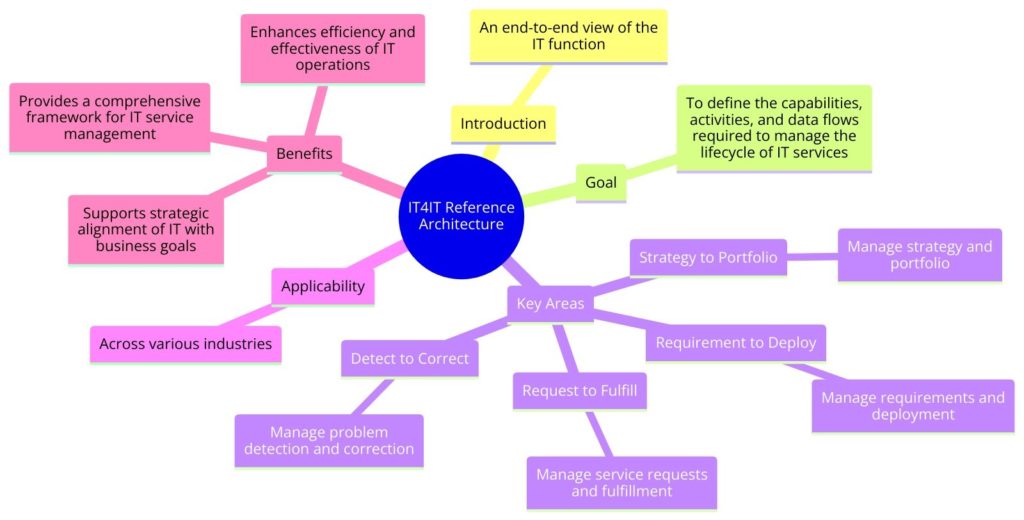IT4IT Reference Architecture
The IT4IT Reference Architecture is a comprehensive framework designed to standardize the management of IT services across the digital enterprise. Developed by The Open Group, an industry consortium that drives the creation of open, vendor-neutral IT standards and certifications, IT4IT provides a blueprint for the IT function to achieve business efficiency and agility. The framework’s version 3.0 represents its latest iteration, focusing on guiding IT organizations through the complexities of digital transformation by offering a value chain-based operating model.
What is IT4IT Reference Architecture?
The IT4IT Reference Architecture offers an end-to-end view of the IT function, defining the capabilities, activities, and data flows required to manage the lifecycle of IT services. Unlike traditional IT management frameworks that focus on processes, IT4IT is structured around the concept of a value chain that comprises four primary value streams: Strategy to Portfolio (S2P), Requirement to Deploy (R2D), Request to Fulfill (R2F), and Detect to Correct (D2C). These value streams provide a high-level framework for delivering and managing IT services, from strategy and requirements through development, deployment, operation, and continual improvement.
Origin of the Framework
The IT4IT Reference Architecture was developed by The Open Group, leveraging the contributions of leading IT practitioners, consultants, and academics. The initiative began as a response to the need for a more standardized, value-oriented approach to managing the IT business, recognizing the challenges posed by the increasing complexity, pace of change, and demand for more agile service delivery models in the digital era.
How It Works
The IT4IT framework is organized around the IT Value Chain and its four major value streams, each addressing a specific aspect of IT service management:
- Strategy to Portfolio (S2P): Focuses on defining the strategy for IT services, managing investments, and aligning the service portfolio with business objectives.
- Requirement to Deploy (R2D): Covers the lifecycle of service development and deployment, from capturing business requirements to delivering IT services into the operational environment.
- Request to Fulfill (R2F): Manages the service catalog and the process of fulfilling service requests, providing users with the services and resources they need.
- Detect to Correct (D2C): Focuses on the operational management of services, including event detection, incident resolution, and problem management.
Each value stream is supported by a detailed reference architecture that defines the essential capabilities, information objects, and technology components required to support IT service management activities effectively.
Why It Is Valuable
IT4IT Reference Architecture provides several benefits for organizations looking to improve their IT operations and align more closely with business goals:
- Standardization and Integration: Offers a standardized approach to IT service management, facilitating better integration and interoperability across disparate tools and systems.
- Efficiency and Agility: Helps organizations optimize IT operations, reduce redundancy, and improve agility in responding to business needs.
- Visibility and Control: Provides a comprehensive framework for managing the IT lifecycle, improving visibility into IT operations, and enhancing control over the IT landscape.
- Guidance for Digital Transformation: Supports organizations in navigating the complexities of digital transformation by providing a clear model for managing digital services and technologies.
When and How to Use It
Organizations can adopt the IT4IT Reference Architecture at any stage of their IT maturity. It is particularly useful for enterprises undergoing digital transformation, seeking to streamline IT operations, or looking to implement a more standardized approach to IT service management. To use IT4IT effectively, organizations should:
- Assess their current IT capabilities and identify gaps relative to the IT4IT Reference Architecture.
- Develop a roadmap for implementing the IT4IT value streams and capabilities, prioritizing areas with the highest impact on business goals.
- Implement changes incrementally, leveraging the IT4IT framework to guide the development and integration of IT services and processes.
- Continuously measure performance and refine IT operations based on insights gained from applying the IT4IT model.
Shortcomings/Criticisms
While the IT4IT Reference Architecture offers a robust framework for managing IT services, it has faced some criticisms:
- Complexity: The comprehensive nature of the framework can be daunting, especially for smaller organizations or those with limited resources.
- Adoption Challenges: Implementing the IT4IT model requires significant organizational change, which can be difficult to manage and sustain over time.
- Flexibility: Some critics argue that the framework may not be flexible enough to accommodate the unique needs and nuances of every organization.
The IT4IT Reference Architecture provides a valuable blueprint for standardizing and improving IT service management across the digital enterprise. By focusing on value streams and providing a detailed reference architecture, IT4IT helps organizations optimize their IT operations, align IT services with business objectives, and navigate the challenges of digital transformation. However, successful adoption requires careful planning, commitment to change management, and a willingness to adapt the framework to the organization’s specific context.


